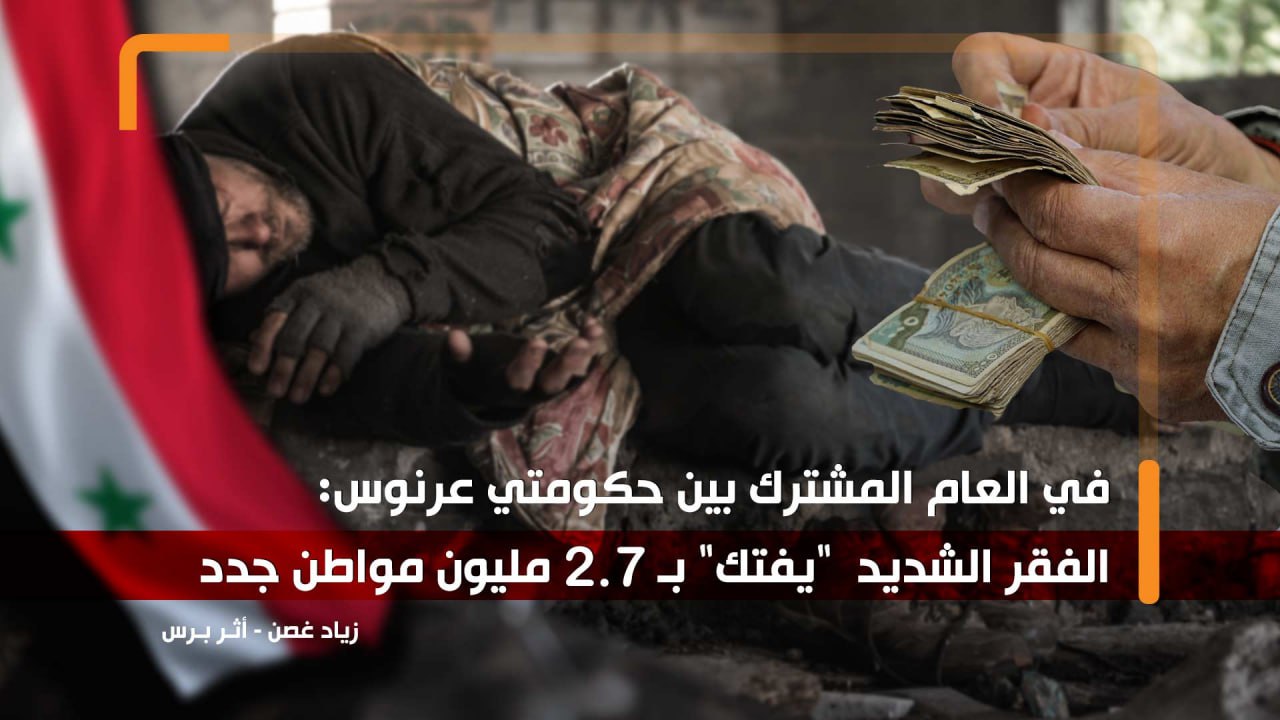A few days ago marked the completion of about a thousand days since Engineer Arnous’ second government assumed office—a significant period in the lives of Syrians, characterized by economic and living conditions that have deteriorated due to a variety of reasons and factors. While it may not be entirely accountable for the occurrence of some of these factors, the government is undeniably responsible for exacerbating them and magnifying their negative effects.
The impact of this economic decline on people’s lives is typically gauged by monitoring various macro and micro indicators, with the prevalence of poverty being one of the most crucial. Both the general public and the elite share a conviction that poverty has surged among Syrians over the past three years. This belief is based on sensory data such as skyrocketing prices and stagnant incomes, as well as reports from UN organizations operating in Syria, which estimate that 14.5 million Syrians urgently require assistance.
Remarkably, during its tenure, the government failed to convene a single meeting to address the reality of poverty or commission relevant research institutions to conduct a comprehensive national survey mapping the extent and severity of poverty—a crucial step for informed policy interventions.
Another glaring issue is the government’s negligence in assessing the impact of its policies, procedures, and decisions on poverty. For instance, despite the continuous escalation of prices for goods and services—both subsidized and unsubsidized—the government has turned a blind eye to its effects on poverty indicators. Instead, it seems intent on concealing these impacts to mask the shortcomings of its policies.
However, there have been recent developments forcing the government to acknowledge some statistical estimates related to poverty in its development report. While this announcement was limited and belated, as it included only one indicator for previous years, it remains a crucial starting point for analyzing poverty during this government’s tenure. According to official data obtained by Athr Press, the rate of severe poverty stood at 54.5% in the last official statistics from 2021. This is a stark increase compared to pre-war levels, which hovered around 8.5%. Even during the height of military conflicts and security deterioration, severe poverty did not surpass 18.8% in 2015, but it rapidly escalated to approximately 38.9% in 2019 and around 39.9% in 2020.
What do these numbers mean?
Different interpretations can be drawn from previous data, but here we’ll focus on the evolution of extreme poverty between 2020 and 2021—a period marked by a significant decline in military conflicts, the assumption of new governmental tasks, and the country’s immersion in successive waves of inflation, exacerbated by the government’s aggressive policy of raising prices for subsidized goods and services. By analyzing this period, we can extrapolate the likely trajectory of extreme poverty in the following years, 2022 and 2023.
Referring to population data published by the Central Bureau of Statistics, we observe estimates indicating 22.5 million people in all governorates of the country in mid-2020 and approximately 22.9 million people in mid-2021. Considering the areas outside government control in the north and east, we’ll rely on estimates of the number of residents in government-controlled areas, approximated by the number of electronic family cards distributed—around 4 million cards in both 2020 and 2021. From this, we can make the following calculations:
Based on prevalence rate estimates of extreme poverty for 2020 and 2021, we estimate approximately 1.596 million families classified as severely poor in 2020 and about 2.180 million families in 2021. Thus, in just one year (2021), the number of Syrian families pushed into extreme poverty increased by roughly 584 thousand families or an average of about 2.744 million people (calculated based on an average family size of 4.7 individuals in Syria).
Given the deepening economic crisis, exacerbated by factors including government policies that hinder production and fuel hyperinflation, alongside the absence of any government programs aimed at alleviating poverty, we anticipate further increases in extreme poverty in 2022 and 2023.
In just one year, during the shared tenure of the first and second Arnous governments, over 2.7 million Syrians have fallen into extreme poverty. This conclusion aligns with the approach outlined earlier. If the government and its relevant ministries have a differing perspective, we await their response.
This article was translated and edited by The Syrian Observer. The Syrian Observer has not verified the content of this story. Responsibility for the information and views set out in this article lies entirely with the author.


